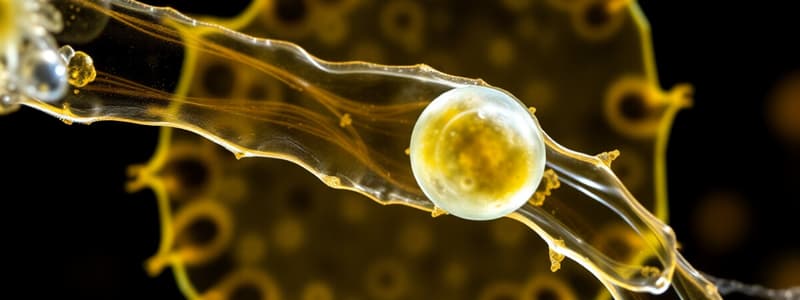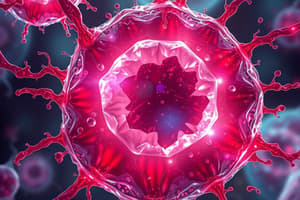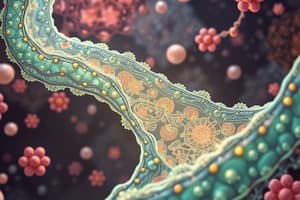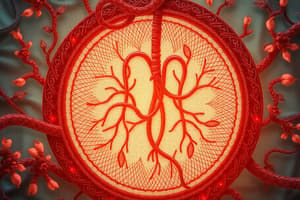Podcast
Questions and Answers
What significant discovery is associated with Watson and Crick in 1950?
What significant discovery is associated with Watson and Crick in 1950?
They discovered the structure of DNA, which contains hereditary information.
How does DNA contribute to cell division?
How does DNA contribute to cell division?
DNA is passed from cell to cell during cell division, ensuring hereditary information is retained.
Which fields converge to form modern cell biology?
Which fields converge to form modern cell biology?
Cytology, biochemistry, and genetics converge to form modern cell biology.
What role did microscopy play in the development of cell theory?
What role did microscopy play in the development of cell theory?
What is endocytosis and what are its two types?
What is endocytosis and what are its two types?
At what size range do cells typically exist on the spectrum of life?
At what size range do cells typically exist on the spectrum of life?
Describe aerobic respiration and its requirement.
Describe aerobic respiration and its requirement.
What is the maximum resolution of a light microscope?
What is the maximum resolution of a light microscope?
What is the significance of mitosis and meiosis in cell division?
What is the significance of mitosis and meiosis in cell division?
Name two subtypes of light microscopy.
Name two subtypes of light microscopy.
What advantage does confocal microscopy offer over traditional light microscopy?
What advantage does confocal microscopy offer over traditional light microscopy?
How many cells does a fertilized oocyte roughly give rise to in a human body?
How many cells does a fertilized oocyte roughly give rise to in a human body?
What does hyperplasia refer to in cellular biology?
What does hyperplasia refer to in cellular biology?
What is hypertrophy and how can it be beneficial or harmful?
What is hypertrophy and how can it be beneficial or harmful?
Why is responsiveness to stimuli considered a fundamental property of all living entities?
Why is responsiveness to stimuli considered a fundamental property of all living entities?
What are differentiated cells and their role in the body?
What are differentiated cells and their role in the body?
What is the smallest living entity according to the provided content?
What is the smallest living entity according to the provided content?
What organisms can viruses infect?
What organisms can viruses infect?
List two characteristics that distinguish viruses from living organisms.
List two characteristics that distinguish viruses from living organisms.
Can viruses grow or reproduce outside of a host cell?
Can viruses grow or reproduce outside of a host cell?
What are prions and how do they differ from viruses?
What are prions and how do they differ from viruses?
Mention one property that all living entities must exhibit.
Mention one property that all living entities must exhibit.
What process do living entities use to take in energy?
What process do living entities use to take in energy?
How do viruses respond to stimuli?
How do viruses respond to stimuli?
What role do antibodies play in fluorescence microscopy?
What role do antibodies play in fluorescence microscopy?
How does a confocal microscope improve imaging compared to standard fluorescence microscopy?
How does a confocal microscope improve imaging compared to standard fluorescence microscopy?
What is the primary advantage of live cell imaging?
What is the primary advantage of live cell imaging?
What resolution can super high-resolution microscopy achieve?
What resolution can super high-resolution microscopy achieve?
What does scanning electron microscopy (SEM) primarily visualize?
What does scanning electron microscopy (SEM) primarily visualize?
What is the difference between transmission electron microscopy (TEM) and scanning electron microscopy (SEM)?
What is the difference between transmission electron microscopy (TEM) and scanning electron microscopy (SEM)?
What defines a living entity in the context of cell biology?
What defines a living entity in the context of cell biology?
What historical significance does microscopy hold in the study of cell biology?
What historical significance does microscopy hold in the study of cell biology?
What term did Robert Hooke coin in 1665 to describe the small structures he observed in cork?
What term did Robert Hooke coin in 1665 to describe the small structures he observed in cork?
What significant contribution did Anton van Leeuwenhoek make to cell biology in 1673?
What significant contribution did Anton van Leeuwenhoek make to cell biology in 1673?
Who concluded that all plant parts are made of cells in 1838?
Who concluded that all plant parts are made of cells in 1838?
What is the main idea behind the cell theory as postulated in the 19th century?
What is the main idea behind the cell theory as postulated in the 19th century?
What did Rudolf Virchow assert about the origin of cells in 1858?
What did Rudolf Virchow assert about the origin of cells in 1858?
Which scientist is known for meticulously grinding lenses to improve microscopy?
Which scientist is known for meticulously grinding lenses to improve microscopy?
In what year did Anton van Leeuwenhoek first document his observations of bacteria?
In what year did Anton van Leeuwenhoek first document his observations of bacteria?
What did the 19th-century cell theory suggest about the cell's role in reproduction?
What did the 19th-century cell theory suggest about the cell's role in reproduction?
What aspect of the 18th century is often viewed as a 'drab century' for scientific advances?
What aspect of the 18th century is often viewed as a 'drab century' for scientific advances?
What role did microscopy play in the field of cell biology?
What role did microscopy play in the field of cell biology?
Flashcards are hidden until you start studying
Study Notes
Endocytosis
- Cells take in substances through endocytosis
- Phagocytosis is "cell eating" - large particles
- Pinocytosis is "cell drinking" - liquids and small particles
Respiration
- All living entities respire
- Respiration releases energy from food
- Aerobic respiration occurs in the presence of oxygen
- Anaerobic respiration occurs in the absence of oxygen
Reproduction
- All living entities reproduce
- Cells reproduce through cell division
- Mitosis occurs in somatic (non-germ) cells
- Meiosis occurs in germ cells (e.g., sperm and oocytes)
- All life originates from pre-existing life
Growth and Development
- All living entities grow and develop
- Cells differentiate and specialize
- A fertilized oocyte develops into a 37-trillion-cell embryo
- There are approximately 210 different cell types in the human body
Cell-Tissue-Organ
- Differentiated cells form tissues and organs
- Tissues and organs perform specific functions
Hyperplasia
- An abnormal increase in organ size due to excessive cell division
- Occurs in response to a stimuli
- Examples include benign prostatic hyperplasia and psoriasis
Hypertrophy
- Cells increase in size (hypertrophy)
- Example: Muscle cells with exercise
Responding to Stimuli
- All living entities respond to stimuli
- Cells divide in response to mitogens
- Cells move in response to morphogens
History of Cell Discovery
- Robert Hooke (1665) coined the term "cells" to describe compartments in cork
- Anton van Leeuwenhoek (1673) pioneered microscopy and observed microorganisms
- Matthias Schleiden (1838) concluded that all plant parts are made of cells
- Theodor Schwann (1839) stated that all animal tissues are made of cells
- Rudolf Virchow (1858) concluded that cells arise from pre-existing cells
The Cell Theory
- All organisms consist of one or more cells
- The cell is the basic structural unit of all organisms
- All cells arise from pre-existing cells
- Modern cell biology combines cytology, biochemistry, and genetics
Microscopy
- Light microscopy played a pivotal role in the development of cell theory
- Electron microscopy allows for higher resolution imaging:
- Scanning Electron Microscopy (SEM) is used to view the surface of structures
- Transmission Electron Microscopy (TEM) is used to view the internal structures of cells
Living Entities
- Not all things that are small are living entities
- Viruses and prions are not considered living entities
- Viruses:
- Are infectious agents consisting of genetic material surrounded by a protein coat
- Infect all organisms
- Can only replicate within a host cell
- Prions:
- Are infectious proteins
- Are resistant to typical sterilization procedures
- Can cause neurodegenerative diseases
Plants
- Plants are living organisms
- Plants harness energy through photosynthesis
- Plants respire
- Plants reproduce
- Plants grow and develop
- Plants respond to stimuli
Harnessing Energy
- Living entities need to take in energy to perform work
- Cells use food for energy
Fluorescence Microscopy
- Uses fluorescent probes to detect specific proteins
- Immunocytochemistry uses antibodies to identify specific proteins in cells
- Immunohistochemistry uses antibodies to identify specific proteins in tissues
Confocal Microscopy
- Allows for 3D imaging by scanning a laser beam across a sample
- Used to study the structure and function of cells and tissues
Live Cell Imaging
- Time-lapse imaging enables the study of cell movement and function in real time
- Allows for investigation of intracellular trafficking - the transport of proteins, vesicles, and organelles within cells
Super High Resolution Microscopy (SHRM)
- Achieves resolutions below 100 nm
- SHRM enhances the imaging of biological structures at the nanoscale
Antibodies
- Antibodies can be used to identify specific cell organelles
- This will be discussed further in future lectures
Learning Outcomes
- Understand what cells are
- Define the concept of a "living entity"
- Outline the history of cell discovery
- Understand the importance of microscopy in cell biology
Studying That Suits You
Use AI to generate personalized quizzes and flashcards to suit your learning preferences.




